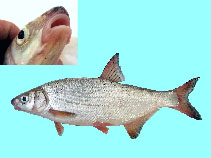ارفع صور و مقاطع فيديو
Pictures | صور قوقلVimba vimba
Picture by Otel, V.
Pictures | صور قوقلVimba vimba
Picture by Otel, V.
Slovenia country information
Common names:
Ogrica
Occurrence: native
Salinity: freshwater
Abundance: | Ref:
Importance: | Ref:
Aquaculture: | Ref:
Regulations: | Ref:
Uses: no uses
Comments: Known from Danube drainage (Ref. 59043). Population has declined due to river regulation. Conservation measures include artificial propagation (Ref. 90061). Status of threat: endangered (Ref. 90061).
National Checklist:
Country Information: https://www.cia.gov/library/publications/resources/the-world-factbook/geos/si.html
National Fisheries Authority:
Occurrences: Occurrences Point map
Main Ref: Povz, M., 1996
National Database:
Occurrence: native
Salinity: freshwater
Abundance: | Ref:
Importance: | Ref:
Aquaculture: | Ref:
Regulations: | Ref:
Uses: no uses
Comments: Known from Danube drainage (Ref. 59043). Population has declined due to river regulation. Conservation measures include artificial propagation (Ref. 90061). Status of threat: endangered (Ref. 90061).
National Checklist:
Country Information: https://www.cia.gov/library/publications/resources/the-world-factbook/geos/si.html
National Fisheries Authority:
Occurrences: Occurrences Point map
Main Ref: Povz, M., 1996
National Database:
Common names from other countries
التصنيف / Names الأسماء الشائعة | مرادفات | Catalog of Fishes(جنس, الانواع) | ITIS | CoL | WoRMS | Cloffa
Environment: milieu / climate zone / depth range / distribution range البيئة
; المياه العذبة; مياه مخلوطة قاعية التغذية و المعيشة; أسماك صاعدة (Ref. 51243). Subtropical; 10°C - 20°C (Ref. 2059); 64°N - 35°N, 12°E - 53°E
التوزيع دول | مناطق الفاو | النظام البيئي | الظهور | Point map | مقدمة | Faunafri
Eurasia: Caspian, Black, Marmara and Baltic Sea basins (Sweden and Finland north to 63°N), North Sea basin from Elbe to Ems drainages. In Anatolia: in Marmara basin, south to Great Menderes and Lake Egridir and east to Kızılırmak drainage. Absent between Kızılırmak and Çoruh drainages. Extirpated in Crimea. Introduced in Rhine.
الحجم / وزن / العمر
Maturity: Lm ? range ? - ? cm
Max length : 50.0 cm TL ذكر/ مختلط الجنس; (Ref. 556); common length : 20.0 cm TL ذكر/ مختلط الجنس; (Ref. 556); أعلا وزن تم نشرة: 1.4 kg (Ref. 35541); العمر: 15 سنين (Ref. 59043)
Max length : 50.0 cm TL ذكر/ مختلط الجنس; (Ref. 556); common length : 20.0 cm TL ذكر/ مختلط الجنس; (Ref. 556); أعلا وزن تم نشرة: 1.4 kg (Ref. 35541); العمر: 15 سنين (Ref. 59043)
وصف مختصر مفاتيح التعريف | الوصف الخارجي | قياسات المظهر الخارجي
الأشواك الظهرية (المجموع) : 3; الأشعة الظهرية الناعمة (المجموع) : 8 - 9; شوكة شرجية: 3; أشعه شرجية لينه: 16 - 22. Diagnosed from its congeners in Europe by the following characters: anal fin with 16-21½ branched rays; back keeled behind dorsal base; in spawning season, males blackish brown with orange cheek and sometimes belly (Ref. 59043). Caudal fin with 19 soft rays. Scalar formula: 49-64, 6-10 (Ref. 40476).
Inhabits brackish estuaries, large to medium rivers and some large subalpine lakes. Sedentary populations inhabit even in small rivers or barbel zone. Feeds mainly on small molluscs and insect larvae. Breeds in riffles in shallow, fast-flowing streams and rivers on gravel. Semi-anadromous populations forage in freshened parts of sea and migrate for long distances to spawn. Lacustrine populations move to fast-flowing tributaries. Spent adults return to foraging habitats (Ref. 59043). Threatened from its range due to water obstruction (Ref. 26100).
Life cycle and mating behavior النضج | التكاثر | وضع البيض | بيض | الخصوبة | Larvae
Produces 15,000-20,000 eggs at the age of 6-7 years (Ref. 12259). Spawns for several years. Semi-anadromous populations undertake long distance spawning migrations while lacustrine populations migrate to fast-flowing tributaries. In Dniepr and Kuban, migration starts in September, decreases in winter and resumes in March-May (Ref. 59043).
المرجع الرئيسي
Upload your references | مراجع | المنظم | المتعاونين
Kottelat, M. and J. Freyhof, 2007. Handbook of European freshwater fishes. Publications Kottelat, Cornol and Freyhof, Berlin. 646 pp. (Ref. 59043)
خطر للأنسان
Harmless
استخدامات بشرية
مصائد: غير مهمة تجارياً; الأستزراع المائي: تجاري; لعبة سمكه: نعم
FAO(مصائد: الأنتاج; publication : search) | FishSource |
مزيد من المعلومات
Population dynamics
معاملات النمو
Max. ages / sizes
Length-weight rel.
Length-length rel.
الطول- الترددات
Mass conversion
توظيف
الوفرة
معاملات النمو
Max. ages / sizes
Length-weight rel.
Length-length rel.
الطول- الترددات
Mass conversion
توظيف
الوفرة
Anatomy
منطقة الخياشيم
Brain
Otolith
منطقة الخياشيم
Brain
Otolith
Physiology
Body composition
Nutrients
استهلاك الأوكسجين
نوع السباحة
سرعة السباحة
Visual pigments
Fish sound
Diseases & Parasites
Toxicity (LC50s)
Body composition
Nutrients
استهلاك الأوكسجين
نوع السباحة
سرعة السباحة
Visual pigments
Fish sound
Diseases & Parasites
Toxicity (LC50s)
Human related
Aquaculture systems
ملامح تربية الأحياء المائية
سلالات
Ciguatera cases
Stamps, coins, misc.
Aquaculture systems
ملامح تربية الأحياء المائية
سلالات
Ciguatera cases
Stamps, coins, misc.
أدوات
Bio-Quiz | E-book | دليل الميدان | Length-frequency wizard | أداة تاريخ الحياة | نقطة علي الخريطة | Classification Tree
| Catch-MSY |
تقارير خاصة
البحث عن صيانت الأحواض المائيه | التحقق من وجود صفحات حقائق الأنواع | البحث عنا حقائق حول الأحواض المائيه
Download XML
مصادر علي الأنترنت
Alien/Invasive Species database | Aquatic Commons | BHL | Cloffa | Websites from users | البحث في مراقبي الأسماك | CISTI | Catalog of Fishes(جنس, الانواع) | DiscoverLife | ECOTOX | Faunafri | Fishtrace | GenBank(الوراثة, نيوكلوتيدة) | GloBI | GOBASE | | Google Books | Google Scholar | Google | IGFA World Record | MitoFish | قاعدة البينات الوطنية | Otolith Atlas of Taiwan Fishes | احواض مائية عامة | PubMed | Reef Life Survey | Scirus | SeaLifeBase | شجرة الحياة | Wikipedia(ذهب, بحث) | World Records Freshwater Fishing | سجلات علم الحيوانات
Estimates based on models
Phylogenetic diversity index (Ref. 82804): PD50 = 0.5625 [Uniqueness, from 0.5 = low to 2.0 = high].
Bayesian length-weight: a=0.00724 (0.00659 - 0.00796), b=3.14 (3.11 - 3.17), in cm Total Length, based on LWR estimates for this species (Ref. 93245).
مستوى غذائي (Ref. 69278): 3.3 ±0.1 se; based on diet studies.
المرونه (Ref. 120179): منخفض, الحد الزمني الأدني لتضاعف عدد أفراد المجتمع 4.5-14 سنة (K=0.22; tm=3; tmax=15).
Fishing Vulnerability (Ref. 59153): Moderate vulnerability (37 of 100).




